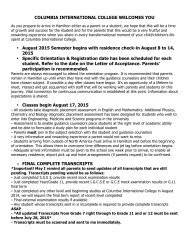french
Create successful ePaper yourself
Turn your PDF publications into a flip-book with our unique Google optimized e-Paper software.
made by others.<br />
This License is a kind of "copyleft", which means that derivative works of the document must themselves be<br />
free in the same sense. It complements the GNU General Public License, which is a copyleft license<br />
designed for free software.<br />
We have designed this License in order to use it for manuals for free software, because free software needs<br />
free documentation: a free program should come with manuals providing the same freedoms that the<br />
software does. But this License is not limited to software manuals; it can be used for any textual work,<br />
regardless of subject matter or whether it is published as a printed book. We recommend this License<br />
principally for works whose purpose is instruction or reference.<br />
1. APPLICABILITY AND DEFINITIONS<br />
This License applies to any manual or other work, in any medium, that contains a notice placed by the<br />
copyright holder saying it can be distributed under the terms of this License. Such a notice grants a<br />
world-wide, royalty-free license, unlimited in duration, to use that work under the conditions stated herein.<br />
The "Document", below, refers to any such manual or work. Any member of the public is a licensee, and is<br />
addressed as "you". You accept the license if you copy, modify or distribute the work in a way requiring<br />
permission under copyright law.<br />
A "Modified Version" of the Document means any work containing the Document or a portion of it, either<br />
copied verbatim, or with modifications and/or translated into another language.<br />
A "Secondary Section" is a named appendix or a front-matter section of the Document that deals exclusively<br />
with the relationship of the publishers or authors of the Document to the Document's overall subject (or to<br />
related matters) and contains nothing that could fall directly within that overall subject. (Thus, if the<br />
Document is in part a textbook of mathematics, a Secondary Section may not explain any mathematics.) The<br />
relationship could be a matter of historical connection with the subject or with related matters, or of legal,<br />
commercial, philosophical, ethical or political position regarding them.<br />
The "Invariant Sections" are certain Secondary Sections whose titles are designated, as being those of<br />
Invariant Sections, in the notice that says that the Document is released under this License. If a section does<br />
not fit the above definition of Secondary then it is not allowed to be designated as Invariant. The Document<br />
may contain zero Invariant Sections. If the Document does not identify any Invariant Sections then there are<br />
none.<br />
The "Cover Texts" are certain short passages of text that are listed, as Front-Cover Texts or Back-Cover<br />
Texts, in the notice that says that the Document is released under this License. A Front-Cover Text may be<br />
at most 5 words, and a Back-Cover Text may be at most 25 words.<br />
A "Transparent" copy of the Document means a machine-readable copy, represented in a format whose<br />
specification is available to the general public, that is suitable for revising the document straightforwardly<br />
with generic text editors or (for images composed of pixels) generic paint programs or (for drawings) some<br />
widely available drawing editor, and that is suitable for input to text formatters or for automatic translation<br />
to a variety of formats suitable for input to text formatters. A copy made in an otherwise Transparent file<br />
format whose markup, or absence of markup, has been arranged to thwart or discourage subsequent<br />
modification by readers is not Transparent. An image format is not Transparent if used for any substantial<br />
amount of text. A copy that is not "Transparent" is called "Opaque".<br />
Examples of suitable formats for Transparent copies include plain ASCII without markup, Texinfo input<br />
format, LaTeX input format, SGML or XML using a publicly available DTD, and standard-conforming<br />
simple HTML, PostScript or PDF designed for human modification. Examples of transparent image formats<br />
include PNG, XCF and JPG. Opaque formats include proprietary formats that can be read and edited only by




